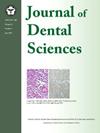Development of zinc partially-stabilized cement carrying growth factor and anti-inflammatory drug for vital pulp therapy
IF 3.1
3区 医学
Q1 DENTISTRY, ORAL SURGERY & MEDICINE
引用次数: 0
Abstract
Background/purpose
Mineral trioxide aggregate (MTA) is recognized as the gold standard for vital pulp therapy. However, its clinical utility is limited by prolonged setting and poor handling characteristics. To overcome these drawbacks, the zinc-containing partially-stabilized cement (ZnPSC), a modified silicate cement, was developed. In this study, the ZnPSC was functionalized with vascular endothelial growth factor (VEGF) and aspirin to enhance its potential as an effective pulp capping material.
Materials and methods
The ZnPSC cements (5 %,7 %, or 10 % of Zn) were combined with poly-γ-glutamic acid (γ-PGA) 1 % or 2 % as a carrier system for VEGF and aspirin. The modified materials were evaluated for the setting time, compressive strength, biocompatibility, controlled drug release, and their ability to promote osteogenic differentiation of dental pulp stem cells (DPSC), assessed by alkaline phosphatase activity and calcium deposition staining.
Results
Incorporation of 1 % or 2 % γ-PGA into 5 % or 7 % ZnPSC cements significantly reduced the setting time and enhanced the compressive strength, overcoming the drawbacks associated with MTA and improving clinical workability. The modified materials exhibited excellent biocompatibility without cytotoxic effects. Furthermore, the sustained delivery of VEGF and aspirin markedly enhanced the mineralization and osteogenic differentiation of DPSCs, as evidenced by increased ALP activity and calcium deposition.
Conclusion
The novel ZnPSC cements functionalized with VEGF and aspirin demonstrated the superior handling properties, mechanical strength, biocompatibility, and enhanced regenerative potential, making it a promising candidate for the vital pulp therapy. Further, in vivo studies are warranted to validate its therapeutic efficacy and biosafety.
含生长因子和抗炎药物的锌部分稳定骨水泥的研制
背景/目的三氧化二矿骨料(MTA)被认为是重要牙髓治疗的金标准。然而,其临床应用受到长时间设置和不良处理特点的限制。为了克服这些缺点,开发了含锌部分稳定水泥(ZnPSC),一种改性硅酸盐水泥。在这项研究中,ZnPSC被血管内皮生长因子(VEGF)和阿司匹林功能化,以增强其作为有效髓盖材料的潜力。材料与方法将锌含量分别为5%、7%和10%的ZnPSC水泥与1%或2%的聚γ-谷氨酸(γ-PGA)结合,作为VEGF和阿司匹林的载体体系。通过碱性磷酸酶活性和钙沉积染色评价改性材料的凝固时间、抗压强度、生物相容性、药物控释以及促进牙髓干细胞成骨分化的能力。结果将1%或2% γ-PGA掺入5%或7% ZnPSC水泥中,可显著缩短水泥的凝固时间,提高水泥的抗压强度,克服MTA的缺点,提高临床可加工性。改性后的材料具有良好的生物相容性,无细胞毒性作用。此外,血管内皮生长因子和阿司匹林的持续递送显著增强了DPSCs的矿化和成骨分化,这可以通过增加ALP活性和钙沉积来证明。结论血管内皮生长因子(VEGF)和阿司匹林功能化的新型ZnPSC骨水泥具有良好的处理性能、机械强度、生物相容性和增强的再生潜能,是重要牙髓治疗的理想材料。此外,还需要进行体内研究来验证其治疗效果和生物安全性。
本文章由计算机程序翻译,如有差异,请以英文原文为准。
求助全文
约1分钟内获得全文
求助全文
来源期刊

Journal of Dental Sciences
医学-牙科与口腔外科
CiteScore
5.10
自引率
14.30%
发文量
348
审稿时长
6 days
期刊介绍:
he Journal of Dental Sciences (JDS), published quarterly, is the official and open access publication of the Association for Dental Sciences of the Republic of China (ADS-ROC). The precedent journal of the JDS is the Chinese Dental Journal (CDJ) which had already been covered by MEDLINE in 1988. As the CDJ continued to prove its importance in the region, the ADS-ROC decided to move to the international community by publishing an English journal. Hence, the birth of the JDS in 2006. The JDS is indexed in the SCI Expanded since 2008. It is also indexed in Scopus, and EMCare, ScienceDirect, SIIC Data Bases.
The topics covered by the JDS include all fields of basic and clinical dentistry. Some manuscripts focusing on the study of certain endemic diseases such as dental caries and periodontal diseases in particular regions of any country as well as oral pre-cancers, oral cancers, and oral submucous fibrosis related to betel nut chewing habit are also considered for publication. Besides, the JDS also publishes articles about the efficacy of a new treatment modality on oral verrucous hyperplasia or early oral squamous cell carcinoma.
 求助内容:
求助内容: 应助结果提醒方式:
应助结果提醒方式:


